Module 7 - Introduction to Solid-State Devices and Power Supplies
Pages i ,
1-1,
1-11,
1-21,
1-31,
1-41,
2-1,
2-11,
2-21,
2-31,
2-41,
2-51,
3-1,
3-11,
3-21,
3-31,
3-41,
3-51,
4-1 to 4-10,
4-11,
4-21,
4-31,
4-41,
4-51, Index
being a "1," orange a "3," and white "9," the device would be identified as a type 139 semiconductor diode, or
specifically 1N139.
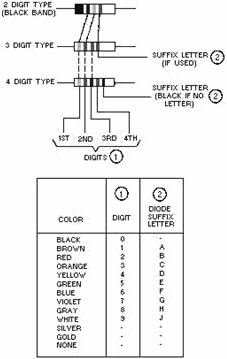
Figure 1-27. - Semiconductor diode color code system. Keep in mind, whether the diode is a small crystal type or a large power rectifier type, both are still
represented schematically, as explained earlier, by the schematic symbol shown in figure 1-12. Q33. What
does the letter "N" indicate in the semiconductor identification system? Q34. What type of diode has
orange, blue, and gray bands? DIODE Maintenance
Diodes are rugged and efficient. They are also expected to be relatively trouble free. Protective encapsulation
processes and special coating techniques have even further increased their life expectancies. In theory, a diode
should last indefinitely. However, if diodes are subjected to current overloads, their junctions will be damaged
or destroyed. In addition, the application of excessively high operating voltages can damage or destroy junctions
through arc-over, or excessive reverse currents. One of the greatest dangers to the diode is heat. Heat causes
more electron-hole pairs to be generated, which in turn increases current flow. This increase in current generates
more heat and the cycle repeats itself until
1-31
the diode draws excessive current. This action is referred to as THERMAL RUNAWAY and eventually causes
diode destruction. Extreme caution should be used when working with equipment containing diodes to ensure that
these problems do not occur and cause irreparable diode damage. The following is a list of some of the
special safety precautions that should be observed when working with diodes:
· Never remove or insert a
diode into a circuit with voltage applied.
· Never pry diodes to loosen them from their circuits.
· Always be careful when soldering to ensure that excessive heat is not applied to the diode.
· When
testing a diode, ensure that the test voltage does not exceed the diode's maximum allowable voltage.
·
Never put your fingers across a signal diode because the static charge from your body could short it out.
· Always replace a diode with a direct replacement, or with one of the same type.
· Ensure a
replacement diode is put into a circuit in the correct direction. If a diode has been subjected to
excessive voltage or temperature and is suspected of being defective, it can be checked in various ways. The most
convenient and quickest way of testing a diode is with an ohmmeter (fig. 1-28). To make the check, simply
disconnect one of the diode leads from the circuit wiring, and make resistance measurements across the leads of
the diode. The resistance measurements obtained depend upon the test-lead polarity of the ohmmeter; therefore, two
measurements must be taken. The first measurement is taken with the test leads connected to either end of the
diode and the second measurement is taken with the test leads reversed on the diode. The larger resistance value
is assumed to be the reverse (back) resistance of the diode, and the smaller resistance (front) value is assumed
to be the forward resistance. Measurement can be made for comparison purposes using another identical-type diode
(known to be good) as a standard. Two high-value resistance measurements indicate that the diode is open or has a
high forward resistance. Two low-value resistance measurements indicate that the diode is shorted or has a low
reverse resistance. a normal set of measurements will show a high resistance in the reverse direction and a low
resistance in the forward direction. The diode's efficiency is determined by how low the forward resistance is
compared with the reverse resistance. That is, it is desirable to have as great a ratio (often known as the
front-to-back ratio or the back-to-front ratio) as possible between the reverse and forward resistance
measurements. However, as a rule of thumb, a small signal diode will have a ratio of several hundred to one, while
a power rectifier can operate satisfactorily with a ratio of 10 to 1. 1-32

Figure 1-28. - Checking a diode with an ohmmeter. One thing you should keep in mind about the ohmmeter check-it is not conclusive. It is still possible
for a diode to check good under this test, but break down when placed back in the circuit. The problem is that the
meter used to check the diode uses a lower voltage than the diode usually operates at in the circuit.
Another important point to remember is that a diode should not be condemned because two ohmmeters give different
readings on the diode. This occurs because of the different internal resistances of the ohmmeters and the
different states of charge on the ohmmeter batteries. Because each ohmmeter sends a different current through the
diode, the two resistance values read on the meters will not be the same. Another way of checking a diode
is with the substitution method. In this method, a good diode is substituted for a questionable diode. This
technique should be used only after you have made voltage and resistance measurements to make certain that there
is no circuit defect that might damage the substitution diode. If more than one defective diode is present in the
equipment section where trouble has been localized, this method becomes cumbersome, since several diodes may have
to be replaced before the trouble is corrected. To determine which stages failed and which diodes are not
defective, all of the removed diodes must be tested. This can be accomplished by observing whether the equipment
operates correctly as each of the removed diodes is reinserted into the equipment. In conclusion, the only
valid check of a diode is a dynamic electrical test that determines the diode's forward current (resistance) and
reverse current (resistance) parameters. This test can be accomplished using various crystal diode test sets that
are readily available from many manufacturers.
1-33
Q35. What is the greatest threat to a diode? Q36. When checking a diode with an ohmmeter, what is
indicated by two high resistance measurements?
Summary Now that we have completed this chapter, a short review of the more important points covered in the
chapter will follow. You should be thoroughly familiar with these points before continuing on to chapter 2.
The UNIVERSE consists of two main parts-matter and energy. MATTER is
anything that occupies space and has weight. Rocks, water, and air are examples of matter. Matter may be found in
any one of three states: solid, liquid and gaseous. It can also be composed of either an element or a combination
of elements. An ELEMENT is a substance that cannot be reduced to a simpler form by
chemical means. Iron, gold, silver, copper, and oxygen are all good examples of elements. A
COMPOUND
is a chemical combination of two or more elements. Water, table salt, ethyl alcohol, and ammonia are all examples
of compounds. A MOLECULE is the smallest part of a compound that has all the
characteristics of the compound. Each molecule contains some of the atoms of each of the elements forming the
compound.
The ATOM is the smallest particle into which an element can be broken down and still retain all
its original properties. An atom is made up of electrons, protons, and neutrons. The number and arrangement of
these particles determine the kind of element.

An ELECTRON carries a small negative charge of electricity. The
PROTON carries a positive charge of electricity that is equal and opposite to the charge of the
electron. However, the mass of the proton is approximately 1,837 times that of the electron.
1-34
The NEUTRON is a neutral particle in that it has no electrical charge. The mass of
the neutron is approximately equal to that of the proton. An ELECTRON'S ENERGY LEVEL is
the amount of energy required by an electron to stay in orbit. Just by the electron's motion alone, it has kinetic
energy. The electron's position in reference to the nucleus gives it potential energy. An energy balance keeps the
electron in orbit and as it gains or loses energy, it assumes an orbit further from or closer to the center of the
atom. SHELLS and SUBSHELLS are the orbits of the electrons in an atom.
Each shell can contain a maximum number of electrons, which can be determined by the formula 2n 2. Shells are
lettered K through Q, starting with K, which is the closest to the nucleus. The shell can also be split into four
subshells labeled s, p, d, and f, which can contain 2, 6, 10, and 14 electrons, respectively.
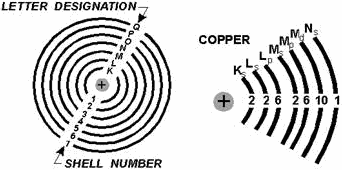
VALENCE is the ability of an atom to combine with other atoms. The valence of an atom
is determined by the number of electrons in the atom's outermost shell. This shell is referred to as the VALENCE
SHELL. The electrons in the outermost shell are called VALENCE ELECTRONS. IONIZATION is
the process by which an atom loses or gains electrons. An atom that loses some of its electrons in the process
becomes positively charged and is called a Positive ION. An atom that has an excess number of electrons is
negatively charged and is called a Negative ION. ENERGY BandS are groups
of energy levels that result from the close proximity of atoms in a solid. The three most important energy bands
are the CONDUCTION Band, forBIDDEN Band, and VALENCE Band.
1-35
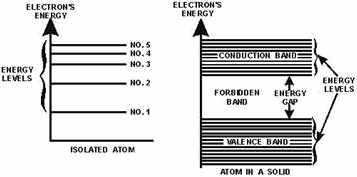
Conductors, Semiconductors, and Insulators are
categorized as such by using the energy band concept. It is the width of the forbidden band that determines
whether a material is an insulator, a semiconductor, or a conductor. a CONDUCTOR has a very narrow forbidden band
or none at all. a SEMICONDUCTOR has a medium width forbidden band. An INSULATOR has a wide forbidden band.
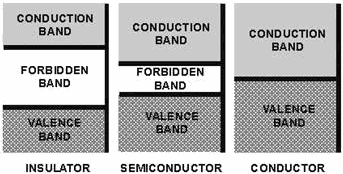 COVALENT BONDING is the sharing of valence electrons between two or more atoms. It is
this bonding that holds the atoms together in an orderly structure called a Crystal.
1-36
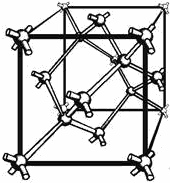
The CONDUCTION PROCESS in a SEMICONDUCTOR is accomplished by two
different types of current flow: HOLE FLow and ELECTRON FLow. Hole flow is very
similar to electron flow except that holes (positive charges) move toward a negative potential and in an opposite
direction to that of the electrons. In an INTRINSIC semiconductor (one which does not contain any
impurities), the number of holes always equals the number of conducting electrons.
 DOPING is the process by which small amounts of selected additives, called impurities,
are added to semiconductors to increase their current flow. Semiconductors that undergo this treatment are
referred to as EXTRINSIC Semiconductors. An N-TYPE SEMICONDUCTOR is one
that is doped with an N-TYPE or donor impurity (an impurity that easily loses its extra electron
to the semiconductor causing it to have an excess number of
1-37
free electrons). Since this type of semiconductor has a surplus of electrons, the electrons are
considered the majority current carriers, while the holes are the minority current carriers.
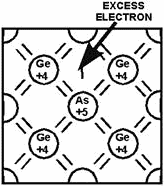
A P-TYPE SEMICONDUCTOR is one which is doped with a P-TYPE or acceptor impurity (an
impurity that reduces the number of free electrons causing more holes). The holes in this type semiconductor are
the majority current carriers since they are present in the greatest quantity while the electrons are the minority
current carriers.
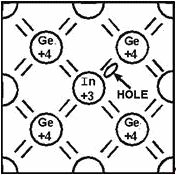
The SEMICONDUCTOR DIODE, also known as a PN JUNCTION DIODE, is a
two-element semiconductor device that makes use of the rectifying properties of a PN junction to convert
alternating current into direct current by permitting current flow in only one direction.
1-38
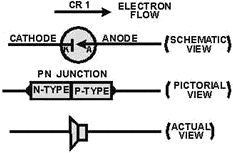
A PN JUNCTION CONSTRUCTION varies from one manufacturer to the next. Some of the more
commonly used manufacturing techniques are: GROWN, ALLOY or FUSED-ALLOY,
DIFFUSED, and Point-CONTACT.
 CURRENT FLow in an N-TYPE MATERIAL is similar to conduction in a
copper wire. That is, with voltage applied across the material, electrons will move through the crystal toward the
positive terminal just like current flows in a copper wire.
1-39
 CURRENT FLow in a P-TYPE MATERIAL is by positive holes, instead of
negative electrons. Unlike the electron, the hole moves from the positive terminal of the P material to the
negative terminal.
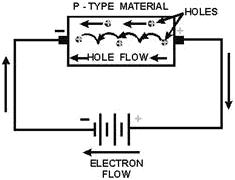 JUNCTION BARRIER is an electrostatic field that has been created by the joining of a
section of N material with a section of P material. Since holes and electrons must overcome this field to cross
the junction, the electrostatic field is commonly called a BARRIER. Because there is a lack or depletion of free
electrons and holes in the area around the barrier, this area has become known as the DEPLETION REGION. 1-40
| - |
Matter, Energy,
and Direct Current |
| - |
Alternating Current and Transformers |
| - |
Circuit Protection, Control, and Measurement |
| - |
Electrical Conductors, Wiring Techniques,
and Schematic Reading |
| - |
Generators and Motors |
| - |
Electronic Emission, Tubes, and Power Supplies |
| - |
Solid-State Devices and Power Supplies |
| - |
Amplifiers |
| - |
Wave-Generation and Wave-Shaping Circuits |
| - |
Wave Propagation, Transmission Lines, and
Antennas |
| - |
Microwave Principles |
| - |
Modulation Principles |
| - |
Introduction to Number Systems and Logic Circuits |
| - |
- Introduction to Microelectronics |
| - |
Principles of Synchros, Servos, and Gyros |
| - |
Introduction to Test Equipment |
| - |
Radio-Frequency Communications Principles |
| - |
Radar Principles |
| - |
The Technician's Handbook, Master Glossary |
| - |
Test Methods and Practices |
| - |
Introduction to Digital Computers |
| - |
Magnetic Recording |
| - |
Introduction to Fiber Optics |
| Note: Navy Electricity and Electronics Training
Series (NEETS) content is U.S. Navy property in the public domain. |
|






















